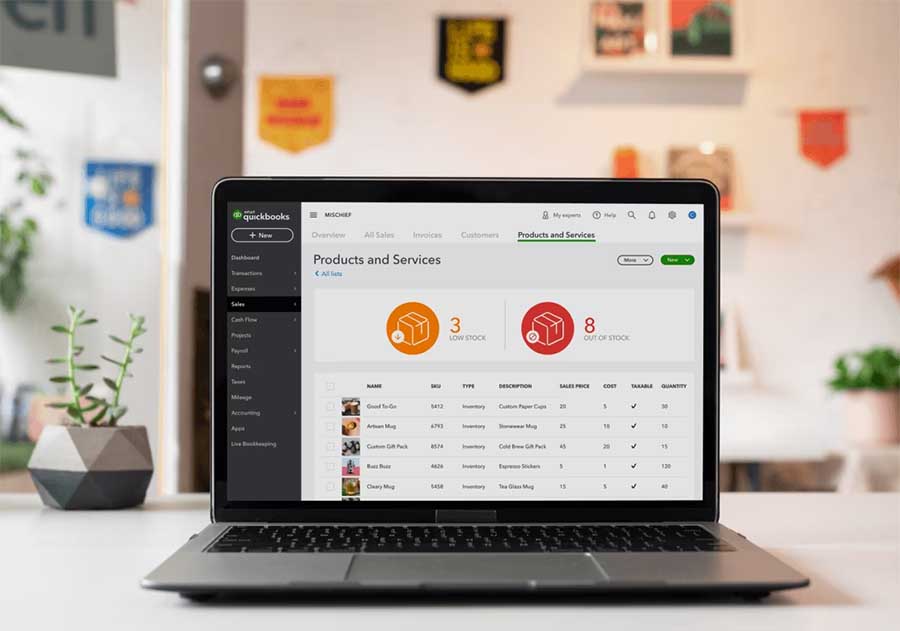
Though QuickBooks has its own inventory management capability with functions like quantity tracking and low stock alerts, you can choose to integrate other software to gain additional or specialized features for better inventory control.
Here are our picks for the best inventory management software that integrates with QuickBooks:
- Zoho: Best overall
- Katana: Best for manufacturers
- Odoo: Best open-source inventory management integration
- Square: Best free software for basic inventory features
- Lightspeed: Best POS and inventory solution for retailers
- Shopify: Best POS and ecommerce platform for omnichannel retail
- MarketMan: Best for restaurants
QuickBooks Inventory Management Integrations Compared
Most of our picks also appear in our ranking of leading inventory management software. Read our buyers’ guide to learn more.
QuickBooks Inventory Capabilities
QuickBooks is at the top of our list of the best accounting software for small businesses. However, the inventory management capabilities of its online version are limited. The desktop version has more robust inventory management features but its subscription fees can be too costly for small businesses.
Before you look for the best inventory management software that integrates with QuickBooks Online, it is essential to understand QuickBooks’ inventory management features and limitations. This will help you determine which functionalities you will still need for your business and whether it’s time to look at QuickBooks integration options.
- Real-time tracking: QuickBooks inventory management provides real-time tracking of sales and inventory status, ensuring you have up-to-date information on stock levels and sales performance.
- Low stock alerts: It can send alerts when inventory levels drop below a specified threshold. This helps avoid stockouts and allows you to reorder products ahead of time.
- Inventory valuation: QuickBooks also calculates the value of your inventory based on the cost of goods sold (COGS).
While QuickBooks offers simple and basic inventory management capabilities, it has limitations that prevent it from handling complex inventory management needs.
- Track inventory in multiple locations: QuickBooks can track financial data across multiple facilities but cannot manage inventory in multiple locations. This limitation challenges businesses with several warehouses or stores, requiring a more sophisticated system for effective stock management.
- Multiple units of measure: QuickBooks Online does not support multiple units of measure for inventory items. This affects businesses needing to buy and sell products in different quantities, such as purchasing by the case but selling individually. Manual conversions are required, which can lead to errors and inefficiencies.
- No bin locations: QuickBooks lacks the ability to track inventory by bin locations within a warehouse. This can be a drawback for businesses that require detailed inventory placement and retrieval processes.
- Limited customization: QuickBooks Online has limited customization options. Businesses needing specific fields or tailored inventory reports may find it insufficient, requiring additional software for more complex needs.
- Barcode scanning: QuickBooks Online does not currently have a built-in system for barcode generation or scanning inventory items. This can be an issue for businesses that rely on barcoding for faster and more accurate inventory management.
- Comprehensive manufacturing support: It cannot handle complex manufacturing processes like bills of materials, work orders, and production tracking. Manufacturers may need specialized software for effective management.
Pros
- Handles multiple channels, warehouses, and currencies
- Free subscription plan
- Bundling, composite, and kitting tools
- Shipping management and expiration date monitoring
Cons
- Lacks return management and other inventory tools
- No forecasting feature
- Sale and purchase order limits
Overview
Zoho takes our top spot because it is incredibly easy to use, offers a free version, and supports two-way sync with QuickBooks Online.
Zoho Inventory software shines at keeping track of large inventories that may be distributed among many warehouses, as well as keeping tabs on older or perishable inventory.
Users can also group and bundle items based on certain attributes (making them easier to market to specific customer demographics), manage stock transfers between warehouses, print shipping labels, pack and send off items, and manage vendors and purchase orders. Integrations are available for post-shipment tracking and ecommerce.
Zoho’s drawbacks include certain missing features such as item return management, rental management, Bill of Material (BOM) functions, pick lists, and bin ID support.
Why QuickBooks Integrates Well with Zoho
Integrating Zoho with QuickBooks allows users of the latter to access all sales and purchases in Zoho Inventory. This is a two-way connection, so you’ll also be able to share existing accounts and contacts between the two software and export transactions and have the corresponding contacts automatically updated in QuickBooks. The same information-sharing function applies to inventory counts and invoices (for which you can enable a multicurrency option).
You can also coordinate data for tax mapping and stock transfers or movements, import contact information from QuickBooks into Zoho, and export invoices and credit notes from Zoho to QuickBooks.
Finally, QuickBooks can also integrate with Zoho’s Timesheet feature for employee management; you can use this to monitor employee login and logout and manage payroll.
- Robust and feature-rich inventory management: Monitor inventory across multiple warehouses; create custom bundles and kits; track expiration dates and perishables; manage vendors.
- Multicurrency handling: Create transactions and manage payments with more than one currency, get automatic exchange rate updating, and view reports that summarize all transactions by contact.
- Numerous integrations: Integrates with Shopify, Etsy, eBay, and Amazon for ecommerce. You can connect with multiple Shopify stores (depending on your subscription), as well as other tools for marketing, CRM, and shipping.
Zoho inventory management is comprehensive, letting you make stock adjustments, create variants, set reorder levels, and more. (Source: Zoho)
Zoho is available with both monthly and annual pricing plans. The monthly costs are:
- Free: $0
- Multicurrency
- Ecommerce integrations
- 50 orders, 1 warehouse, 20 purchase orders per month
- Standard: $39 (annual $29)
- Additional warehouses and users
- 500 orders, 1 warehouse, 300 purchase orders per month
- Professional: $99 (annual $79)
- Vendor portal
- Serial number tracking
- 3000 orders, 2 warehouses, 1500 purchase orders per month
- Premium: $159 (annual $129)
- Batch tracking
- 7500 orders, 3 warehouses, 3000 purchase orders per month
- Enterprise: $299 (annual $249)
- Advanced multicurrency
- 15000 orders, 7 warehouses, 7500 purchase orders per month
Katana: Best for Manufacturers
Pros
- Track items by expiration date
- Manage product variants and materials
- Start-to-finish tracking along the entire manufacturing process
- Automate data transfers for accounting
Cons
- No free plan; only one user per plan
- App not available in baseline plan
- Support via email only
- Lacks first-in, first-out (FIFO) costing method
Overview
Katana Manufacturing ERP software was designed specifically for manufacturing companies. With Katana, production and scheduling are visible on one platform and updated in real time.
This lets you make data-driven decisions and ensure that inventory levels remain optimal at all times, avoiding both overstock and shortages. You can track materials along the entire manufacturing process, including items that might be expiring and those in different warehouses.
However, Katana does have a few drawbacks—the lack of a free plan, limited users, limited support, and the higher fees required if you want specialized features such as warehouse management or expiration tracking.
Why QuickBooks Integrates Well with Katana
Keeping track of manufacturing processes is complex given all the moving parts: production schedules, materials tracking, expiration dates, purchase orders, stock transfers, and more.
Syncing Katana with QuickBooks Online will help greatly with simplifying these processes, letting you automate data transfers between the accounting and manufacturing software.
With the QuickBooks integration through Katana, you can:
- Sync inventory balances between the two systems
- Convert purchase orders from Katana into bills in QuickBooks Online with a single click
- Sync customer and vendor contact information.
- All-level control of production, scheduling, and manufacturing: Keep a close eye on high-level concerns such as inventory, materials availability, and cost calculations; as well as floor-level tasks like task scheduling and time tracking.
- Granular purchase order tracking: Log supplier names, expected arrival dates, delivery locations, tax percentages, and even payment currencies. You can also automate the purchasing process.
- Custom workflows via Katana API: Use the software’s API to create make-to-order workflows and other automations that simplify and streamline your operations.
Purchase orders let you track many different types of information, and can be automated. (Source: Katana)
- Starter
- Monthly: $199 per month
- Annual: $179 per month
- 1 inventory location
- Up to 1200 sales orders
- Integrations
- Standard
- Monthly: $399 per month
- Annual: $359 per month
- 3 inventory locations
- Up to 6,000 sales orders
- Multi-currency
- Barcode scanning
- Professional
- Monthly: $899 per month
- Annual: $799 per month
- 10 inventory locations
- Up to 18,000 sales orders
- Full traceability via batch numbers or serial numbers
- Expiration date tracking
- Warehouse management
- Professional Plus
- Monthly: $1,999 per month
- Annual: $1,799 per month
- Unlimited inventory locations
- Up to 40,000 sales orders
Odoo: Best Open Source Inventory Management Integration
Pros
- Free inventory management software
- Automatic stock replenishment/purchase orders available
- Double-entry inventory system
- High customizability
Cons
- Implementation and customization can be challenging
- Installation, troubleshooting, and updating are up to the user
- Limited customer support
- Extra fees for other tools and functions
Overview
Odoo takes a top spot for inventory management integrations because it is quick and simple to obtain (being an open source software), offers a ton of useful features right from the start, and is free for both inventory management and invoicing functions.
With Odoo’s free default inventory management module, you’ll be able to replenish stock via automatic quote requests to suppliers. You can set these automatic requests to go out whenever your inventory levels get low, or based on sales forecasting, or other logistics rules—it’s up to you.
Odoo also has a double-entry inventory system, letting you keep a more accurate record of when and where every item moves, leading to greater accountability and fewer errors—which means more efficient transactions and happier employees and customers.
Odoo’s open source nature can be a curse as well as a blessing, however; you’ll have to do all the installation and troubleshooting yourself, as customer support is quite limited. You’ll have access to extensive online documentation to help you, though.
Odoo released its latest version, v17, in November 2023. Full documentation for troubleshooting is available on the Odoo website.
Why QuickBooks Integrates Well with Odoo
QuickBooks and Odoo integrate in a two-way sync, meaning you can import and export data between the two systems: purchase orders, inventory, payment and expenses, and data on customers, vendors, and employees.
Odoo’s automatic stock replenishment and purchase order capability mesh well with QuickBooks, as accounting becomes more efficient when stock depletion and renewal are more predictable.
Odoo’s double-entry inventory system, in particular, works well with QuickBooks, as the former is designed specifically for greater accuracy and fewer errors when tracking stock movement—which are invaluable for someone doing business accounting.
Just keep in mind that because Odoo is open-source, integration with QuickBooks isn’t very straightforward—you’ll need to use a connector app to link the two, and these third-party apps can cost upwards of $200. Here is one example: Odoo QuickBooks Online Connector PRO by VentorTech.
- Inventory forecasting and automatic vendor request-for-quote (RFQ): You can set Odoo to automatically track your inventory and contact vendors for a price quote when stock levels go below a predetermined level.
- Double-entry inventory management: Greater transparency and accuracy of accounting and inventory movement. Inventory across all store locations is immediately updated.
- Built-in expiration date tracking: Minimizes wasted stock and helps prevent over-ordering, leading to higher efficiency and profits.
Odoo’s inventory module allows you to process receipts, delivery orders, and returns. The software is available on desktop and Android or iOS apps.
Odoo is open source software and is highly customizable. The inventory management features are included in the free plan, but you can choose to pay extra fees for plans that give you wider access to additional apps and modules.
- Free plan available (for one app only)
- Standard
- Monthly: $31.10 per user, per month
- Annual: $24.90 per user, per month
- Custom
- Monthly: $46.80 per user, per month
- Annual: $37.40 per user, per month
Square: Best Free Option with Basic Inventory Features
Pros
- Free plan with optional upgrades
- Industry-specific software versions available
- Omnichannel sales and syncing available
- Simple and intuitive interface
Cons
- Free plan has limited inventory features
- Only integrates with Square payment processor
- Limited support hours and customization
Overview
Square is a fantastic software system in general—it is our best overall POS system—its inventory management features are easy to use, sufficient for small businesses, and of great quality considering the software is free.
Though, its functionality doesn’t match up to that of more robust paid software systems. The free subscription will let you edit product options, create categories, and receive low stock alerts in your inbox. However, you’ll need to upgrade to a paid subscription to unlock advanced inventory features like bulk intake and counts, stock forecasts, and vendor or purchase order management. It is also not as granular or customizable as Lightspeed.
For these reasons, we recommend Square’s inventory management system mainly for users needing basic features or prefer a free plan. Square Inventory still works well as integration with QuickBooks if you’re doing accounting for a smaller or new business that doesn’t need complex inventory management. If you need more detail, go with Lightspeed; if you want more flexibility, try Odoo.
Need help with setting up or optimizing the software? Check out our detailed guide for Square Inventory management, which includes step-by-step instructions and a video.
Why QuickBooks Integrates Well with Square
Square’s reliable low stock alerts combine well with a similar feature in QuickBooks. The latter’s real-time inventory tracking also works well with Square’s built-in online store builder, ensuring that you have enough product to stock both your online and physical stores.
While third-party apps that integrate Square with QuickBooks exist, the most efficient way to do the integration is to use the free Connect to Square app. Besides giving you access to Square’s tools, including its inventory management, this can also import sales data from Square into QuickBooks.
This means that whether you are using QuickBooks and want to connect it to Square or vice versa, the Connect to Square app gets the integration done for you and opens up all the benefits for both accounting and inventory management.
You can see how this process works and get started with the integration using QuickBooks’ guide.
- Automatic low stock alerts: Square will send low-stock alerts to your inbox when inventory levels fall too low. I have tested these alerts and found them to be consistent, reliable, and persistent (until you turn them off or replenish your stock).
- Easily edit product options and variants: Square’s inventory management interface is generally easy to use, and you can quickly set up multiple product variants and options.
- Inventory reporting tools available: By upgrading to a higher plan, you can use several inventory reporting tools such as cost of goods sold, projected profits, inventory sell-through, and more.
Square Inventory lets you easily set product options and variants such as different sizes or colors.
Square for Retail
- Free plan available (plus one free card reader)
- Plus: $60 per month, per location
- Discounted processing fees
- Advanced inventory management
- Advanced reporting
- Vendor management
- Premium: Custom pricing (includes one-on-one onboarding support)
Square for Restaurants
- Free plan available (plus one free card reader)
- Plus: $60 per month, per location
- Advanced reporting
- Premium: Custom pricing for high-volume sellers (>$250,000 per year)
Lightspeed: Best for Brick-and-Mortar Retailers
Pros
- Detailed inventory management
- Return management feature
- Built-in purchase ordering
- Integrated supplier network catalog
Cons
- Can get expensive, especially for smaller businesses (No free plan)
- User interface can be challenging to get used to
- Does not have functions for managing perishable goods
Overview
Lightspeed’s inventory management stands out among many other systems for its level of granularity and numerous features—customizability, native purchase ordering tools, low stock alerts, work order management, bulk pricing and editing, supplier network, and more.
As with Odoo, built-in purchase orders and low-stock alerts make it much easier to order new items as needed and prevent depleted stock that could grind your business to a halt. An integrated supplier network catalog is available, giving you access to more than 3,000 vendors from which you can choose the best options.
Lightspeed’s weak points include a potentially difficult user interface and a fairly high price point that presents a barrier to very small or new businesses.
Why QuickBooks Integrates Well with Lightspeed
Lightspeed is built to handle high inventory and sales volumes. Even if you’re using QuickBooks to do accounting for a large and complex business, Lightspeed can keep up. Lightspeed’s purchase ordering and ability to track and manage inventory in detail also align with similar features in QuickBooks.
Integration with QuickBooks Online will allow for regular syncing between the two software systems, letting you view updated accounting data, payments, quantities, and costs.
For example, you can use Lightspeed POS to pay for an invoice, and this action will automatically be updated and recorded in QuickBooks. Because this integration is a two-way sync, you can also do this in the opposite direction, performing actions in QuickBooks and having them recorded in Lightspeed. Multilocation capability is present as well.
You can use specialized apps to connect QuickBooks Online with Lightspeed; here is one option starting at $30 per month.
- Detailed inventory management: Create and track item categories, serial numbers, stock-keeping units, and product bundles and kits.
- Integrated supplier network catalog: Thousand of choices of vendors with viewable built-in catalogs.
- Returns management: Set and manage vendor returns as needed (automation available).
Lightspeed boasts granular inventory management with a high level of customizability for product categories, bundles, and kits.
Lightspeed Retail
- Basic
- Monthly: $109 per month
- Annual: $89 per month
- Core
- Monthly: $179 per month
- Annual: $149 per month
- Plus
- Monthly: $289 per month
- Annual: $239 per month
Shopify: Best for Ecommerce & Omnichannel Retail
Pros
- Sync inventory with major sites such as Facebook and Amazon
- Numerous advanced features available (with extra fees)
- User-friendly mobile app
- Many apps and integrations available
Cons
- Third-party apps can be pricey
- Real-time shipping rates and shipping calculator require higher plans
- Not the best choice for brick-and-mortar-only businesses
- No free domain for online stores
Overview
Shopify is mainly known as a best-in-class ecommerce platform—it lets you track and sell items across different marketplaces and social channels. It also offers a POS system and many useful inventory management features, such as inventory tracking counts, order fulfillment, low stock alerts, and multilocation management. You can fulfill orders in-store, online, or curbside, and even manage returns or exchanges for items purchased online.
This is why Shopify is our pick as the best integration for managing inventory when it comes to omnichannel sales. No other software can quite match up when it comes to juggling both in-person buyers and online shoppers, and the software’s flexible inventory management features reflect this.
Combine this with QuickBooks’ solid accounting functionality, and you’ll be able to handle even a complex business model with lots of inventory movement and shoppers both online and in your physical store.
That said, many of Shopify’s strongest inventory management features require you to subscribe to higher plans. The process for unlocking full functionality can also get complicated: you’ll need to subscribe to a Shopify ecommerce plan and upgrade to POS Pro.
Why QuickBooks Integrates Well with Shopify
This integration is a one-way push, sending your ecommerce data from Shopify to QuickBooks for accounting. As with Square, QuickBooks’ real-time inventory tracking also synergizes with Shopify to help you keep track of both online and physical store inventory; in fact, this is even more suitable for Shopify given how well this system works for ecommerce.
Both QuickBooks and Shopify also let you connect with popular apps such as Amazon to stay on top of your inventory and boost omnichannel sales.
- Omnichannel selling: The software’s centralized inventory management lets you manage items, transactions, and deliveries for just about any combination of in-store and online purchasing.
- Strong multilocation functionality: All of Shopify’s ecommerce plans let you manage inventory for up to 1,000 locations.
- Stocky app: Once you have Shopify POS Pro, you can take things further with the Stocky app. Stocky gives you rich vendor management features, including purchase orders, product recommendations to increase profits, counting stock on hand and adjusting as necessary, and stock analytics and in-depth reporting.
The Stocky app combined with Shopify POS Pro gives you the highest possible level of inventory management functionality, including demand forecasting and detailed reports. (Source: Shopify)
You’ll need to subscribe to a Shopify plan in order to use Shopify’s POS system and inventory functions. Here is the pricing for Shopify’s ecommerce plans:
- Basic
- Monthly: $25 per month
- Annual: $19 per month
- Shopify
- Monthly: $65 per month
- Annual: $49 per month
- Advanced
- Monthly: $399 per month
- Annual: $299 per month
- Shopify Plus (for high-volume businesses): From $2,300
Once you’ve subscribed, you can upgrade the POS from Lite to Pro for an additional monthly fee. If you then use the Stocky app with POS Pro, you’ll be at the highest level in terms of inventory management options.
- Shopify POS Pro
- Monthly: $89 per month, per location
- Annual: $79 per month, per location (billed yearly)
MarketMan: Best for Restaurant-specific Inventory Management
Pros
- Ingredient-level inventory management
- Menu reports let you determine the most and least profitable items
- Detailed supplier management
- Lots of functionality and available integrations
Cons
- Expensive subscriptions
- Multiple location tracking only available on the most expensive plan
Overview
MarketMan is a heavy-duty inventory and vendor management app designed for just about any size or type of restaurant. This software always has a high place in our list of restaurant inventory management software due to its vendor management and information storage, ingredient-level inventory that gets updated in real-time, tracking and logging for both food production and waste, multilocation tools, and much more.
The only real downsides of MarketMan are that it’s designed specifically for restaurants, so other business types might not find it as useful; and it’s not cheap, with no free plan available either. Though, you can be sure that you’re getting your money’s worth with this software.
Why QuickBooks Integrates Well with MarketMan
Integration between QuickBooks and MarketMan is one-way; you’ll be importing data from MarketMan into QuickBooks. This includes transactions and even invoicing—with MarketMan, you can first upload a copy (or even a photo) of your business invoices, and the software will automatically update your inventory counts without any further action from you.
Then you can import the data in QuickBooks, ensuring accurate and timely logging of payments, expenses, and other crucial data. The integration performs this down to the line item level, saving you lots of time and headaches while doing accounting.
This level of granularity makes accounting much more efficient and less prone to user error that could result in unbalanced books. The more your invoicing and inventory changes are automated and updated in real time, the more accurate your overall bookkeeping will be.
- Ingredient-level inventory breakdowns: Menu items can be viewed and counted by ingredients, portions, recipes, and images. Allergen tracking is also available. All information can be accessed on any connected device.
- Easy and automatic updates of invoices and accounts payable: Automatic updating of items, quantities, and payments—all from a single uploaded invoice copy or photo.
- Automated, granular vendor management: Automatic purchasing orders with adjustable limits, budgets, and other criteria.
MarketMan allows for precise price tracking for ingredients, among other useful inventory and vendor management functions. (Source: MarketMan)
MarketMan inventory management software comes in three available plans. You can request a demo via the MarketMan website, but no long-term free plan is available. Note that monthly plans will be charged an additional one-time $500 setup fee. Annual plans may also be available
- Operator: $239 per month, per location
- Inventory counting and transfers
- Accounts payable management
- 30 invoice scans per month
- Professional: $299 per month, per location
- Vendor management automation
- Inventory waste tracking
- Advanced reporting
- 50 invoice scans per month
- Ultimate: $429 per month, per location
- Additional vendor integrations
- 150 invoice scans per month
How We Evaluated Inventory Management Integrations for QuickBooks
Our main consideration when choosing the best inventory management integrations was to look for software features that would combine well with QuickBooks Online in terms of functionality and purpose. Since QuickBooks is used for accounting purposes like invoicing, tracking of expenses and income, and payment of bills, we looked for inventory management integrations that would make these things easier.
Automation was a big plus point for potential software providers, as automated processes remove the human error element, making accounting easier and more accurate.
We also looked for inventory management features that are useful in general: inventory counts, low-stock alerts, detailed reporting, and vendor management.
Frequently Asked Questions (FAQs)
Click through the sections below to read answers to common questions about the best inventory management software that integrates with QuickBooks:
Many inventory systems integrate with QuickBooks online. The top ones include Zoho Inventory, Katana, Odoo, Square, Lightspeed Retail, Shopify, and MarketMan.
Yes, Zoho Inventory integrates with QuickBooks. This integration allows you to sync your inventory, orders, and accounting data seamlessly between the two systems, providing a comprehensive solution for managing your business finances and inventory in one place.
Yes, Square can be used for inventory management. Square for Retail offers inventory tracking features, including stock management, low-stock alerts, and detailed reporting, making it suitable for small to medium-sized businesses.
Bottom Line
If you choose to go beyond QuickBooks’ native inventory management, you have several integration options for advanced functionality. Both free plans with basic features and high-end plans with tons of functions are available.
When selecting inventory software that integrates with QuickBooks Online, you can even choose the best option for your business type: general retail, restaurant, online selling, and more. No matter what kind of business you’re running or what your budget looks like, there’s something for you.





